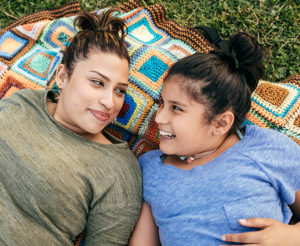7 Questions to Ask Before Your First Foster Care Placement

After going through the training and certification process to become foster parents, new foster parents eagerly wait for a child or teen in foster care to be placed in their home. We recently sat down with KVC Foster Care Supervisor Becca Crook to address the most common questions people have about their first foster care placement.
The answers to these seven questions will help new foster parents prepare to welcome a child into their home.
Help children and teens who have experienced abuse, neglect or other serious challenges. Learn about becoming a foster parent today!
Q: When can I expect my first foster care placement?
A: It varies.
 Crook explains, “There isn’t a perfect answer to this. We have to consider each youth’s specific needs and work hard to find a home that is able to meet each youth’s needs. We work with foster parents to teach them about a child’s needs and encourage them to commit to them during the time the child needs a safe, loving home.”
Crook explains, “There isn’t a perfect answer to this. We have to consider each youth’s specific needs and work hard to find a home that is able to meet each youth’s needs. We work with foster parents to teach them about a child’s needs and encourage them to commit to them during the time the child needs a safe, loving home.”
Crook says that when finding the perfect fit for families and kids, it isn’t just about age and gender. A variety of factors contribute to placing a child in the right foster home.
Q: Can I choose the age and gender of my first foster care placement? How many children can I foster in my home at one time?
A: Yes and yes
Crook explains, “Yes, you can specify the age and gender of children you would like to foster. Children in foster care range in ages from birth to 19.”
But Crook noted that it’s teenagers who are in the “greatest need for loving families,” and if potential foster parents request young children under the age of five, KVC will educate individuals about older children’s needs or suggest other agencies. That being said, it’s generally difficult for agencies to fulfill the request of families to only take very young children. KVC is dedicated to helping families and kids find placements that will work for everyone involved.
“KVC also helps families grow their abilities and learn about the need for homes for youth of all ages and genders,” Crook says. “There will be times where we will contact you because we believe you can meet a need of certain youth outside of your range. And, the more open your age and gender preferences are, the quicker you will have a placement.”
If you are willing and have the space, often multiple siblings may need a home together.
“There is also a need for families to care for sibling groups of two or more children,” Crook says. “To ensure every child in your home has enough space, each child must have their own bed.”
Q: How long will a child in foster care be in my home?
A: It depends on the child’s case plan and the realities of life. However, safely reuniting a child with their family in under a year is always KVC’s goal.
 Crook explains, “The first goal for each child is to reintegrate them back into a safe and stable environment with their birth family. When reunification is possible, we strive to accomplish this within one year of a child’s removal from the home. The length of stay in a foster home and in foster care varies depending on the progress of the case plan.”
Crook explains, “The first goal for each child is to reintegrate them back into a safe and stable environment with their birth family. When reunification is possible, we strive to accomplish this within one year of a child’s removal from the home. The length of stay in a foster home and in foster care varies depending on the progress of the case plan.”
Ultimately, the length of a child’s stay is decided by the courts in conjunction with the child’s case management team. The parties responsible and the process varies a bit depending on the state in which you reside.
“The state — or in some states, the nonprofit case management provider — are the legal guardians for children who are wards of the state and will make the decision with the help of the youth’s team—attorneys, guardian ad litem, among others,” Crook says. “If foster parents take placement of a youth in probation, the judge will make the decision based on information provided or suggested by the probation officer. The parents remain the legal guardians in these cases. KVC believes the first placement should be the child’s last placement before achieving permanency, or safely reunifying with their family, adoption, guardianship.”
Another factor to consider is the age of the child, as the age of majority varies. Children typically “age out” of foster care around 18 years old. Crook adds that this is important for families to think about when they are fostering older children. They can help them prepare for adulthood, and may also consider adopting the youth so they have a permanent family and home.
“When a youth is close to the age of majority when they are placed in a foster home, it’s really important the foster family is prepared, proactive and consistent with helping the youth work on skills to help them be successful adults,” Crook says.
Filling out college and/or job applications and learning about insurance, how to make appointments, budgeting, grocery shopping, and paying bills are some of the things foster parents should be thinking about and teaching their older child in foster care.
Q: I work full-time. Can a child in foster care attend daycare?
A: Yes, depending on if the daycare accepts state subsidy.
 Daycare is a topic that varies widely by state. But in general, Crook explains, “Children in foster care can attend daycare. Many of our foster parents work full-time, and KVC can help parents find an approved daycare to watch the child.”
Daycare is a topic that varies widely by state. But in general, Crook explains, “Children in foster care can attend daycare. Many of our foster parents work full-time, and KVC can help parents find an approved daycare to watch the child.”
Approved daycares are those that accept state subsidies.
If children are older, they should be in school—and attending the same school they attended before their placement. Crook discusses this as something to consider when thinking about routines and expectations for new children placed in a foster home.
“Kids need to remain in the school they are attending when they are placed in your home,” Crook says. “Removing a child from their school can cause a lot of trauma for a child and delays in their education. It also removes them from one of their most important community connections. Their friends attend these schools and the school’s staff already know the child.”
Q: What do family visits look like and how are they arranged?
A: Depending on the case plan, arrangements vary, but may occur on a regular basis.
 Crook explains, “Each child in state custody has visiting time with their biological family regularly while in foster care. Ideally, these visits occur in the family home or in the family’s community. Foster parents are encouraged to assist in transportation or aid in the facilitation and interaction with the family, depending on the circumstances.”
Crook explains, “Each child in state custody has visiting time with their biological family regularly while in foster care. Ideally, these visits occur in the family home or in the family’s community. Foster parents are encouraged to assist in transportation or aid in the facilitation and interaction with the family, depending on the circumstances.”
While the answer to this question varies based on specific circumstances, the most important aspect of family visits is communication—both with the child and their family. With the child, foster parents need to create a safe space where the child feels comfortable opening up and being honest about how they feel about family visits. With the child’s family, foster parents should have a working relationship in order to coordinate and do what’s best for the child.
“Foster parents are a resource for the child while the biological family overcomes obstacles and challenges until the child can safely return home,” Crook says. “With this in mind, we encourage foster parents to create an environment of open communication when safely possible. It’s really about shared parenting! Foster parents must connect with the biological parents soon after placement. Foster parents have an important role in helping build a healthy relationship with the biological parents. The child and the parents feel supported and this encourages a healthy, successful time while the youth is in the home. Foster parents should form a team with the child’s parents and everyone should work together.”
Q: Can we take children in our care out of town or on vacation with us?
A: Yes.
 Crook explains, “Your state agency or nonprofit case management provider and the parents of the child in care can approve or deny a request from the foster parents to take a child out of town or on vacation. One reason it may be denied would be if it were to interfere with the child’s visitation. They also have to approve any out-of-state travel. If the request is approved, a travel letter is written and sent with the child stating they are in state custody and they are approved to leave the state. This letter will need to stay with the child and foster family in case of emergencies. If the request is not approved, the child can be placed in respite care—which is another licensed foster home, or a different approved temporary home.”
Crook explains, “Your state agency or nonprofit case management provider and the parents of the child in care can approve or deny a request from the foster parents to take a child out of town or on vacation. One reason it may be denied would be if it were to interfere with the child’s visitation. They also have to approve any out-of-state travel. If the request is approved, a travel letter is written and sent with the child stating they are in state custody and they are approved to leave the state. This letter will need to stay with the child and foster family in case of emergencies. If the request is not approved, the child can be placed in respite care—which is another licensed foster home, or a different approved temporary home.”
Other considerations can include the time it takes for paperwork to be completed, whether you are able to take a child outside of the country, and if the child can miss school.
“Paperwork is often quick and easy if you, the foster parent, are on top of it. As for leaving the country and having the child miss school, both are possibilities and have happened before.”
Q: Do children in foster care have health insurance, or will I need to cover them? What about school tuition, dental, food, and clothing?
A: Yes, children in foster care should have health insurance, and the daily reimbursement should cover daily living expenses.
Crook explains, “Children in foster care have medical, vision and dental insurance provided for them by the biological family or through Medicaid when needed. Foster parents receive a daily reimbursement from the state. The youth’s specific needs and what foster parents need to do to meet them determine the reimbursement amount. The reimbursement is to help cover clothing, activities, and school-related fees as well as basic daily living expenses. KVC can also assist in helping find community resources to meet additional needs.”
 When it comes to medical care, the child should continue to see the doctor they always see. Youth must have a physical scheduled with that doctor soon after being placed with a new family.
When it comes to medical care, the child should continue to see the doctor they always see. Youth must have a physical scheduled with that doctor soon after being placed with a new family.
If a child needs to go to the emergency room, foster parents should take them. On the way to or at the hospital, foster parents should notify the KVC staff on-call via phone as soon as they are able, as well as the state agency hotline or the nonprofit case management provider.
Reimbursement should be spent on daily life, including clothes, hygienic products, and food for the child in your care. KVC and community liaisons offer youth in foster care multiple opportunities to get new things. Bi-annual trips to the Foster Care Closet and welcome boxes ensure youth have what they need.
School tuition is typically a non-factor, Crook says. “[I would say about] 99.9% of the youth we serve are enrolled in public schools. If the youth is attending a private school, the parents would need to continue to pay this.”
There are many other questions new foster parents might have about welcoming their first foster care placement into their home. Our supportive, knowledgeable staff and network of experienced foster parents are always ready to help.
How to help children and teens in your community
Currently, more than 400,000 children and teens are in the foster care system in the United States. Many of these youth have experienced abuse, neglect, or other family challenges and have been removed from their homes by the courts for their safety. Foster families provide care and support for these youth while they are in out-of-home care. It only takes ONE caring adult to change a child’s life. Learn more about becoming a foster parent today!

